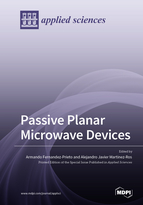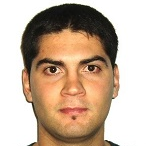Passive Planar Microwave Devices
A special issue of Applied Sciences (ISSN 2076-3417). This special issue belongs to the section "Optics and Lasers".
Deadline for manuscript submissions: closed (20 August 2020) | Viewed by 43776
Special Issue Editors
Interests: printed passive microwave; components and metamaterials
Special Issue Information
Dear Colleagues,
Passive planar circuits play a key role in many RF/microwave applications, such as wireless communications, medical instrumentation, and remote sensing. Planar technologies were born during World War II but their use did not became popular until the 1960s (at that time, planar structures were referred as to as two-dimensional flat-surface layered topologies). Since then, the use of classical planar structures, such as striplines, microstrips, and coplanar waveguides, in high-frequency applications has drastically increased, becoming indispensable elements if devices with low weight and low cost are critical. Even today, new planar technologies are still being investigated and developed as evidenced by the most recent Substrate-Integrated Waveguide (SIW) structure. This Special Issue is focused on highlighting recent contributions on microwave devices developed on planar technologies, and encourages original contributions related, but not limited to, the following topics:
- two-port circuits, such as filters;
- multiport circuits, such as dividers, combiners, couplers, and multiplexers;
- microwave sensors; and
- antennas.
Dr. Armando Fernandez-Prieto
Dr. Alejandro Javier Martinez-Ros
Guest Editors
Manuscript Submission Information
Manuscripts should be submitted online at www.mdpi.com by registering and logging in to this website. Once you are registered, click here to go to the submission form. Manuscripts can be submitted until the deadline. All submissions that pass pre-check are peer-reviewed. Accepted papers will be published continuously in the journal (as soon as accepted) and will be listed together on the special issue website. Research articles, review articles as well as short communications are invited. For planned papers, a title and short abstract (about 100 words) can be sent to the Editorial Office for announcement on this website.
Submitted manuscripts should not have been published previously, nor be under consideration for publication elsewhere (except conference proceedings papers). All manuscripts are thoroughly refereed through a single-blind peer-review process. A guide for authors and other relevant information for submission of manuscripts is available on the Instructions for Authors page. Applied Sciences is an international peer-reviewed open access semimonthly journal published by MDPI.
Please visit the Instructions for Authors page before submitting a manuscript. The Article Processing Charge (APC) for publication in this open access journal is 2400 CHF (Swiss Francs). Submitted papers should be well formatted and use good English. Authors may use MDPI's English editing service prior to publication or during author revisions.
Keywords
- microwave;
- microstrip;
- stripline;
- coplanar waveguide;
- substrate-integrated waveguide (SIW);
- planar circuit;
- antenna;
- sensoring.







